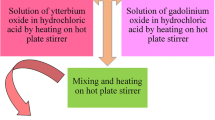Abstract
Fully stabilized zirconium dioxide is widely used. One of the basic requirements to this material is the thermal stability of the structure. The most effective stabilizer for zirconium oxide is yttrium oxide. However, the structure of Y-ZrO2 degraded at low temperature. Partial substitution of Fe3 + for Y3+ decreases both the crystallization and sintering temperature of zirconia ceramic.
The aim of present work is the investigation of structural peculiarities of zirconium oxide stabilized by combined dopant depending on chemical composition, synthesis conditions and heat treatment.
The polymorphic composition of a ZrO2-based materials has been determined in series of samples that correspond to the formula [1−(x+y)]ZrO2⋅xY2O3⋅yFe2O3 in the temperature range 620–1570 K. It has been found that at the same molar ratio ZrO2 : doping oxides, the degree of ZrO2 stabilization increases, and the low-temperature degradation process is retarded by the partial substitution of Fe3 + for Y3+. Nonequivalent sites of Fe3 + ions have been identified: two with octahedral coordination for CPH and three with octa-, penta- and tetrahedral coordination for SPH. The possibility of cluster distribution of Fe3+ ions and the dependence of the number of vacancies on synthesis conditions have been shown.
Similar content being viewed by others
References
I. V. DEDOV, V. A. KONASOV, V. A. MATYUKHA and A. I. SOLOVYOV, “Materials and Nanostructures: Production, Properties, Applications,” in: Proceedings of An Interregional Conference with Foreign Participants (Krasnoyarsk, 1996) p. 126.
O. VASYLKIV and Y. SAKKA, J. Amer. Ceram. Soc. 84(11) (2001) 2489.
V. V. VIKTOROV and A. A. FOTIEV, Inorg. Mater. 29(9) (1993) 1254.
F. F. LANGE, G. L. DUNLOP and B. I. DAVIS, J. Amer. Ceram. Soc. 69(3) (1986) 237.
T. T. LEPISTO and T. A. MANTYLA, Ceram. Eng. Sci. Prod. 10(7–8) (1989) 1362.
A. G. BELOUS, Y. V. PASHKOVA, A. N. MAKARENKO, B. S. KHOMENKO and I. Y. PISNCHAI, Inorg. Mater. 33(12) (1997) 1469.
V. G. PEICHEV, S. Y. PLINER and A. A. DOBIZHA, Steklo i Keramika (3) (1991) 26.
H. YANAGIDA, Metallurgia, Moscow (1986) p. 279.
Certificate of Analysis. Standard Reference Material 1976, Instrument Sensitivity Standard for X-ray Powder Diffraction (Gaithersburg: National Institute of Standards and Technology, 1991) p. 1–4.
T. V. CHUSOVITINA, Y. S. TOROPOV and M. G. TRETNIKOVA, Ogneupory (8) (1991) 14.
Y. N. KNIPOVICH and Y. V. MARACHEVSKII, Gosud. Nauchno-Tekhnich. Izdatelstvo Khim. Literatury, Leningrad, (1956) p. 1055.
Reagents. Chelatometric method for the determination of main-substance content, GOST 10398-76, Moscow, 1976.
V. P. CHALYI, Naukova Dumka, Kyiv (1972) p. 153.
A. N. MAKARENKO, A. G. BELOUS and Y. V. PASHKOVA, J. Europ. Ceram. Soc. 19 (1999) 945.
G. TEUFER, Acta Cryst. 15 (1962) 1187.
C. J. HOWWARD, R. J. HILL and B. E. REICHERT, ibid. 44 (1988) 116.
O. C. KISTNER and A. W. SUNYAR, Phys. Rev. Letters. 4(8) (1960) 412.
G. SHIRANE, D. E. COX and S. L. RUBY, Phys. Rev. 125(4) (1962) 1158.
F. N. RUBY and V. Y. ARSENIN, Nauka, Moscow (1979) p. 285.
G. BENCROFT, A. MEDDOK and R. BERNS, in “Fizika Mineralov,” Mir, Moscow (1971) p. 179.
G. BENCROFT, R. BERNS and A. STONE, in “Fizika Mineralov,” Mir, Moscow (1971) p. 205.
R. D. SHANNON and C. T. PREWITT, Acta Cryst. B25 (1969) 925.
G. A. OLKHOVIK, I. I. NAUMOV, O. I. VELIKOKHATNYI and N. N. APAROV, Inorg. Mater. 29(5) (1993) 636.
F. J. BERRY, M. H. LORETTO and M. R. SMITH, J. Solid State Chem. 83(1) (1989) 91.
D. A. ZYUZIN, E. M. MOROZ, A. S. IVANOVA and V. I. ZAIKOVSKII, Inorg. Mater. 36(4) (2000) 447.
A. P. SHPAK, Y. A. KUNITSKII and Z. A. SAMOILENKO, Akademkniga, Kyiv (2002) p. 167.
Author information
Authors and Affiliations
Rights and permissions
About this article
Cite this article
Belous, A.G., Pashkova, E.V., V'Yunov, O.I. et al. Effect of combined doping (y3 + + fe3 +) on structural features of nanodispersed zirconium oxide. J Mater Sci 40, 5273–5280 (2005). https://doi.org/10.1007/s10853-005-0842-1
Received:
Accepted:
Issue Date:
DOI: https://doi.org/10.1007/s10853-005-0842-1




